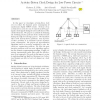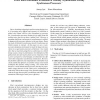403 search results - page 25 / 81 » Gradient clock synchronization |
ISLPED
2003
ACM
14 years 1 months ago
2003
ACM
A significant fraction of the total power in highly synchronous systems is dissipated over clock networks. Hence, low-power clocking schemes would be promising approaches for futu...
ICCAD
1995
IEEE
14 years 7 days ago
1995
IEEE
In this paper we investigate activity-driven clock trees to reduce the dynamic power consumption of synchronous digital CMOS circuits. Sections of an activity-driven clock tree ca...
WDAG
2007
Springer
14 years 2 months ago
2007
Springer
Consider a distributed network of n nodes that is connected to a global source of “beats”. All nodes receive the “beats” simultaneously, and operate in lock-step. A scheme ...
ISCA
2002
IEEE
14 years 1 months ago
2002
IEEE
Due to shrinking technologies and increasing design sizes, it is becoming more difficult and expensive to distribute a global clock signal with low skew throughout a processor di...
IPSN
2010
Springer
14 years 3 months ago
2010
Springer
We present Virtual High-resolution Time (VHT), a powerproportional time-keeping service that offers a baseline power draw of a low-speed clock (e.g. 32 kHz crystal), but provides...


